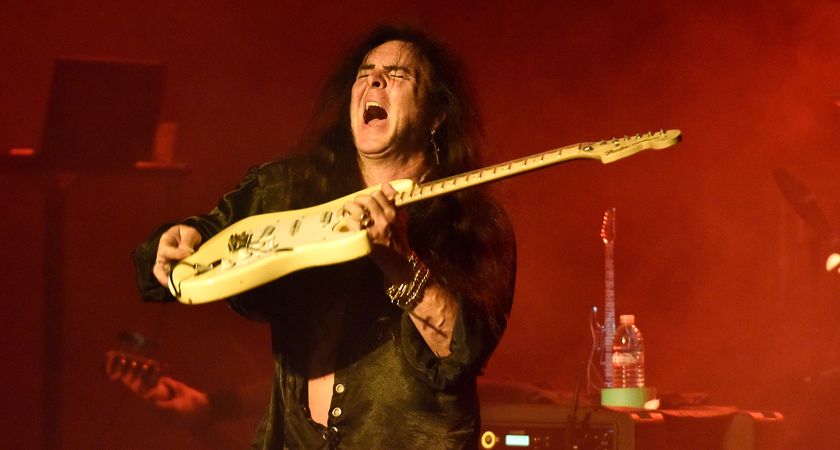Speaking in Tongues: Gene Simmons
Inside the KISS man's mind
Gene Simmons really needs no introduction. He is quite possibly the most identifiable bassist in the history of rock music. Even if you aren't familiar with some of his iconic bass-lines, his demonic onstage persona has been entrenched in pop culture for four decades now. And though Kiss's image has been a hallmark of the band's career, it also often overshadows just how musically diverse they really are.
Simmons may espouse two of the three dictats of a life lived on stage and under the spotlight - sex and rock'n'roll; no drugs for him - but it may come as a surprise to many that he is as comfortable referencing Gilbert and Sullivan as he is the Beatles. With a 2014 Rock And Roll Hall Of Fame induction notched in his belt and a solo box set titled Gene Simmons: Alter Ego in the final stages of completion, Simmons took a moment out of his ever-busy schedule to talk to BGM about his influences, his basses and the stories behind some of Kiss's most iconic songs.
Simmons, born Chaim Witz in Haifa, Israel in 1949, was 13 years old when he first saw the Beatles on television. It's a moment etched so vividly on his brain that it's obvious it helped influence Kiss's identity. "I remember thinking they looked weird," he recalls. "They were very small people by American standards, and they looked feminine." Simmons remembers them as having doll-like features, and that they didn't seem to share any of the ethnic characteristics of New York City, where he moved at the age of eight. "They didn't look Italian or Jewish or Greek or black. They didn't even look like hoodlums." His mother commented that they looked silly, and suddenly he realised that must mean they looked cool. "Because my mother thought they looked silly," he emphasises.
Though initially challenged by their image, Simmons was aware that the Beatles made the perfect statement from a marketing perspective. "They looked like what they sounded like. I was watching the music. I was listening with my eyes and I noticed that the girls were screaming and that they were playing their own instruments."
It was an epiphany for the young Simmons. Most groups at that time, such as the Temptations and the Four Seasons, were vocal groups with bands backing them up. "They wore suits like my father did," he says. "But the Beatles looked like dolls with their Beatles suits and their Beatle haircuts. It was as if they'd all came from the same Beatle mother. That was the pivotal moment for me."
With the Beatles as his muse, Simmons first learnt guitar before noticing that everybody wanted to be a guitarist: he decided he would have a better chance of joining a band if he played bass. "There were fewer people who wanted to do the bass thing: it was just pragmatism," he admits. He points out that his hero, Paul McCartney, was also a guitar player first, in the Quarrymen, before they became the Beatles and he switched to bass.
Simmons says he has always played bass with a pick thanks to the simple fact that he didn't know any better. "I didn't know you were supposed to play with your thumb," he confesses. Playing with a pick shaped his identity on bass, which he says is mostly a melodic approach. "If you're glued to the kick drum, your melodies are limited," he points out. "Clearly the bass in a string quartet doesn't have to worry about a drummer: he's busy playing his own melodies."
Get the MusicRadar Newsletter
Want all the hottest music and gear news, reviews, deals, features and more, direct to your inbox? Sign up here.
He points to the Percy Mayfield tune 'Hit The Road, Jack', as another pivotal moment. "The bass riff is the whole song," he says. "It's not about the chords; everybody just plays 'Bom, bom, bom, bom' and it never goes into a bridge. The verse is the chorus and the chorus is the bridge. I'll never forget that."
Later came the Beatles, and, more specifically, McCartney. "I started to hear the Beatles riffs, where the bass riff was also what the guitars were playing, almost like horn parts. When I first heard those Beatles records, I realised that McCartney was different to the Motown bassists I was used to hearing. The Motown bassists were all about feel. You felt them and they made you tap your feet and groove, but you didn't go around humming the bass-lines Carol Kaye or James Jamerson were playing. It was all feel. It's about the rhythm, whereas you actually hum McCartney's bass-lines. You hear the bass playing in your mind, because it's memorable. Bass in Motown is a rhythmic instrument. There are a lot of inferred notes in the way they play. And I don't infer notes. I play them."
As iconic a persona as Simmons is, he has never been identified with landmark bass shapes such as Fender Precision or Jazz basses. Instead, he gravitated towards the meaty tone and big body of Gibson Grabbers and Rippers. These were eventually usurped by the Spector bass. He famously played, and adopted as his primary instrument, one of the very first Spector basses ever built. In fact, he claims it was number one.
"Some guy walked in when we were recording the third record, and he said, 'Hi, I'm Stu Spector'. I was like, 'Great, how did you get in here?'" Simmons laughs. Spector told the bassist that he was a fan and wanted to build him a bass. "He asked me what kind of bass I would like, so I said, 'I hate it when I can't reach up and do the kinds of slides that I like doing, like a little sugar coating.' I wanted a fully exposed neck. There's no reason why the body, like on a Fender bass, should leave about a third of the neck within the body: you can't reach the top notes." This was the impetus for the double horn that is now an integral design component of his own Punisher bass. Simmons refers to it as a uniform body, due to the way the double horns mirror one another and allow him to reach the upper frets. The Gene Simmons Punisher is a version of that first Spector.
Simmons has been manufacturing his own basses under the moniker Gene Simmons Axe Company since 1980. "I had one made because I noticed that musicians call their instruments, 'Axe'," he says, recalling his first bass. "So I did some research and found out that nobody had ever actually trademarked the term, even though it was in common usage. So I trademarked the word and then asked myself, 'Why doesn't a guitar look like an axe?'"
Kramer built the first few hundred of the original Axe basses and thereafter Jackson made some, but Simmons wasn't satisfied, so he did the research and development himself. Today, each Simmons bass is handmade, starting at about five grand and you can even buy the ones he plays on stage - literally. If Kiss come to your city and you like the one Simmons is playing, you can buy that one.
Simmons has been manufacturing his own basses under the moniker Gene Simmons Axe Company since 1980. "I had one made because I noticed that musicians call their instruments, 'Axe'," he says, recalling his first bass. "So I did some research and found out that nobody had ever actually trademarked the term, even though it was in common usage. So I trademarked the word and then asked myself, 'Why doesn't a guitar look like an axe?'"
Kramer built the first few hundred of the original Axe basses and thereafter Jackson made some, but Simmons wasn't satisfied, so he did the research and development himself. Today, each Simmons bass is handmade, starting at about five grand and you can even buy the ones he plays on stage - literally. If Kiss come to your city and you like the one Simmons is playing, you can buy that one.
Simmons says he has experimented with five- and six-string basses off stage, but never found them useful for his role in Kiss. "I've tried it, but it's too many choices," he says. "You ever go to a restaurant and you see the menu and you get a hundred choices? My sense is that the five- and six-string bass work better for different kinds of music, like jazz and prog rock. Four strings are plenty for me. I do play chords on some of the stuff. All you have to do is play the one and the five - and there's your chord."
When it comes to songwriting, Simmons says it's not about riffs for him. "Many musicians often sit down and start aimlessly reading off the things they remember," he states. "Like a Page lick or Clapton lick, and it's sort of mindless. When I pick up an instrument it's because I heard something in my head first, then I search for it."
He adds: "You can tell an AC/DC song starts with Angus Young sitting down and strumming the chords," he says. "There's a process to what they do. There's no process here. On Gene Simmons: Alter Ego, you'll hear hundreds of songs that I never used in Kiss. Beatle-esque songs, other songs like Neil Young: just all kinds of stuff that never fit what we did. They were written on all kinds of instruments. There are no rules."
People can be dismissive of Kiss's music because the image is overwhelming, but Simmons emphasises that there is substance to the simplicity of their songs. "Yngwie Malmsteen is a very good guitar player, but nobody is walking down the street humming those riffs. Something that's memorable is worth more than anything. Deep Purple's 'Smoke On The Water' guitar lick is the most played guitar lick of all time. When you really think about it, simple and good last."



“Those arpeggios... That was the sickest thing I ever heard”: Yngwie Malmsteen on why guitarists should take inspiration from players of other instruments if they want to develop their own style

“I used a flange on the main riff and a wah-wah on the solo. I just said, ‘Hit the record button and I’ll let it rip!’”: Kiss legend Ace Frehley on his greatest cult classic song









